ALEXANDER RICHARDS WATSON
East London, South Africa
Alexander Richards Watson was my paternal grandfather. I never met him as he died early, but he played an important role in my life. Family lore has it that he arrived in South Africa as a young man with references from an English bank and found employment in the Standard Bank. He was to settle in East London.
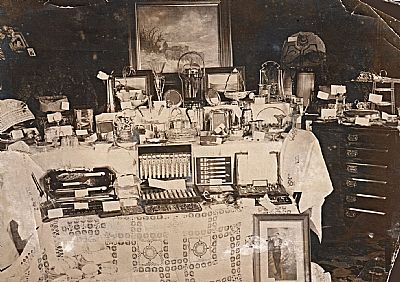
This photo is labelled "Maud & Alex's Wedding Presents 1911". We very a similar chunky fish serving set of cutlery and silver rests as in that presentation box on the left, but from my wife's family. The silver teapot with the black handle and the sauceboat are likewise similar, but not from this set.
The following notes are from my father Brian Watson, son of Alexander Richards Watson. I am not sure of the date they were typed up, but I do know that he compiled much of this in the 1980s and -90s. Quotes in dark red. My own notes in black.
Alexander Richards Watson was born born at 41 Hill Park Crescent, Plymouth on 31st January, 1873. His mother Dinah registered his birth as Father James Watson Watson, an Engineer Officer R. N. was on the China Station in H. M. S. Thetis. He was often away as letters written by A.R.W. To his Father indicate; and after James W. W. retired from the navy they lived at 25 Smeaton Avenue, Mutley Plain, Plymouth.
Alex (our Dad) was in the Cornish Bank for some 13 years before resigning as cashier in February 1901. He had received a letter from the London Branch of the Standard Bank of South Africa Limited dated 21st February, 1901 appointing him in the Colonial Services of this Bank to a clerkship at £225-0-0 per annum. As the Bank bore the cost of his passage he had to stay for a minimum of 2 years. His fidelity had to be guaranteed in an amount of £1,000-0-0.
Dad sailed for the Cape on S. S. Kinfauns Castle of 9664 Tons as a first saloon passenger on 23rd March, 1901. He landed at Cape Town and came up to East London.
In January 1902 his salary as teller was raised to £240-0-0 and in January 1903 a further £ 20-0-0 was added to his salary.
When his obligatory years of service were completed Dad left the Bank and set himself up as an accountant under the title Watson and Co. He did quite well especially as he handled many insolvent estates which occurred after the conclusion of the Anglo-Boer War.
In the East London Daily Dispatch at this time he advertised himself as a stockbroker. His address was 8 Britannia Arcade (between Terminus and Union Streets) (more recently rebuilt as Colonial Mutual Arcade).
Dad lived for a while in “Bachelor Quarters” behind the Beach Hotel (now Kennaway Hotel); in a row of wood an iron rooms facing Rees Street.
In 1906 Alex R. Watson was elected Secretary to the E. L. Choral Society; also Honorary Secretary / Treasurer to the Society for the prevention of Cruelty to Animals.
We were told that Grandfather J. W. W. ) had been retired from the navy at an early stage because of his health. Notwithstanding this he lived to a good age; it is also said that Dad (A.R.W.) would have become a concert pianist if his father could have afforded the training).
My father, Brian Watson's notes continue on about the Newmans into which family A. R. W. had married. I have selected those passages relevant to our current subject (picking up on the other information elsewhere).
Maud Newman's father had built a fine double storied house in St Peters Road in East London.
From this house too Maud and Alex were married in the Congregational Church by Rev. Martin Dower on 20th May, 1911. The little flower girls were Marjorie Miller and Lilian Jones, cousins of the bride. The bridesmaid was Norah Humphrey. The bridegroom was supported by Frank Richardson. “Among the many beautiful presents received were a silver entree dish, suitably engraved from the Ladies Hockey Club of which the bride was captain and a handsome rosewood music cabinet from the staff of Mackenzie Bros; also a presentation from the bridegroom's office staff”. (D. D. report); there is also the family an E. P. N. S. coffee pot engrave M. W. from E. L. L. H. C.
D. D. = Daily Dispatch.
Some of those surnames sound familiar to me – either family connections or families of long standing within East London.
Alexander occurs again in my father's notes when writing about his uncle A. W. Newman. (There is much overlap with the lives of the Newmans. Fred and Tom noted below were Alexander's Newman nephews) :
Business had become bad following the depression of 1905.
In 1911 the firm's name was changed to Newman, Watson and Newman – Alex R. W. (Dad) having apparently given up his own professional office joined A. M. Newman in an effort to reconstruct the firm and he and Mother moved into the double storey with baby Jack Montague Watson who had been born in April, 1912.
Very shortly thereafter Grandfather Newman died suddenly on 6th June 1912. An extract of his will indicates that he was an uncertified insolvent with no property.
The Watsons, and the twins Fred and Tom who were brought back from Kingswood College, soon all moved into a smaller house at 13 St. Peters Road. Uncle Cliff Miller with his wife Alice lived in the adjoining house 15 St. Peters Road. Alex R. W. set himself up as a broker and commission agent and the Watson family moved to 23 St. Peters Road (note – street numbering has changed), while the Newmans moved into a house in Belgravia Crescent where Alison Marion was born on 31st January, 1913.
In 1914 the Watsons, the Newmans and Granny Newman plus Tom and Fred moved to Argo House – a large house in Vincent (later a boys hostel for Cambridge School under the Reverend Bickerdike). This was just after the birth of George Dennison and Reginald Scott – Maud's twin sons on 22nd January, 1914; here Nevill Edwin Miller Newman was born on 10th October 1914. Argo House was a large house with 13 rooms and a large garden with tennis court, oranges and fowl runs. Each family had a large bedroom and sitting room; there was a huge drawing room, all served by 4 maids and a garden boy. Here they all lived for three years.
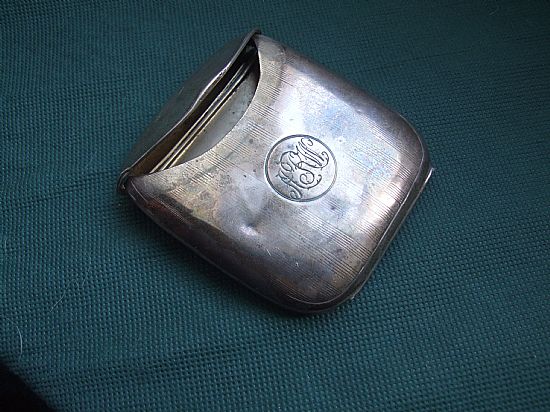
This is a card case with ARW inscribed on it.
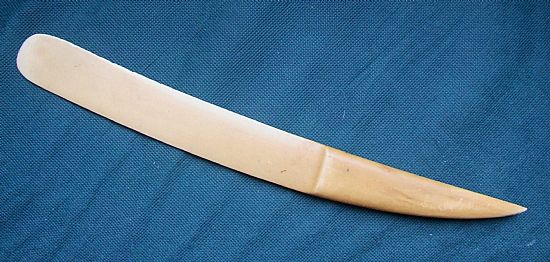
This is an ivory paper knife - about as long as a laptop screen. I also used it for years when an architect when paper and pens were still used.
An extract from Clarissa Newman's memoirs appears in my father's notes : “Fresh business worries caused many problems – the Newmans used up their savings and Alexa Watson's coal business helped till Dad (Put) got back some of the lost shipping”. (Clarissa was my father's aunt. She was referring to her dad).
This all gives a rather bleak picture, but the families stuck it out and supported each other admirably.
My father used to point to the photo below of East London Harbour on the mouth of the Buffalo River and identify his ship with some sentimental pride yet mixed with questions. By ship we are talking of one which was no longer under its own steam. He would hire for it to be towed to Durban where it would be filled with coal which was sold in East London. You can see a tug in one of the pictures, but I wonder if that small boat, a paddle steamer, towed this heavily laden listing one all the way or merely got it to its berth. Sounds precarious to me.
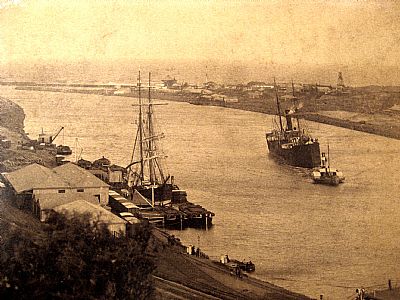
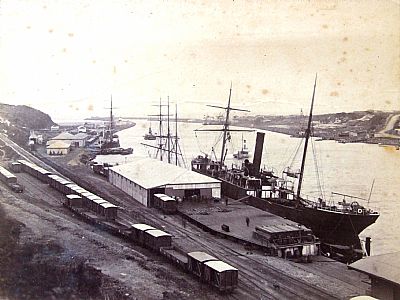
My father continues:
Dad (Alex Richards Watson) had purchased the hul “Chittagong” in July 1907 and eventually sold it in January 1917 to the S. A. Shipping Co. Ltd. Originally built as the S. V. Arundel Castle of 1042 tons in 1864, it was sold in 1883.
As the “Imperator” it arrived in East London on May 1901 with storm damage. Dad bought it and as the “Chittagong”, he used it as a hulk which was towed by tug to Durban and brought back with a load of coal. This made a fair living.
In his son, Jack's letter of 24/5/94 to my father, Jack says : I knew about the "hulk" Chittagong from him, but I did not know that he worked it so long transporting coal from Durban to Cape Town, (or other ports) I was too young to be aware of what was going on. The hulk was towed by a tug. and he told me that it ran aground at the end.
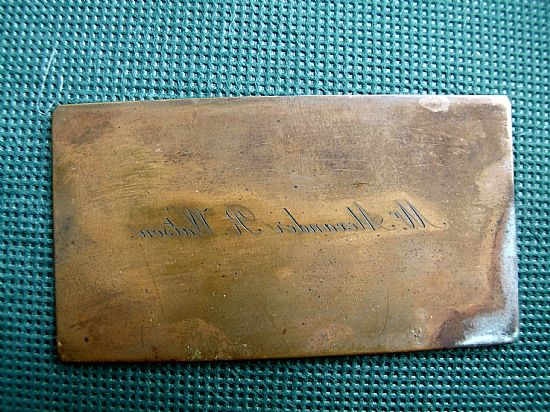
Above is an etched name plate, one of two, in reverse for printing.
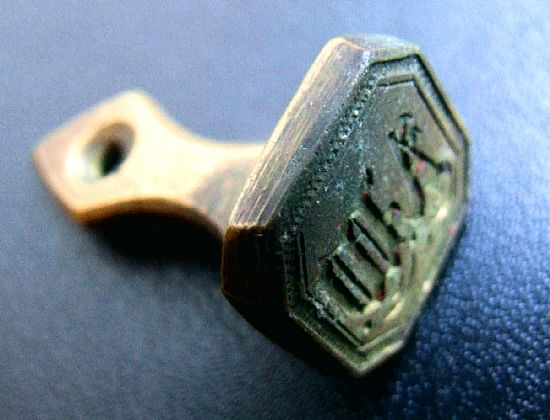
And a seal with his initials. Remember the days of sealing wax? Probably not. I only remember because it was a cool thing to do. Packages would be sealed and then have red (usually) applied to the seals of tape or string. If the package arrived with the seal broken you suspected it had been tampered with.
We have a large thermometer on our wall with the label : ST O'GORMAN'S CATTLE DIP. MADE IN ONLY ONE QUALITY, THE BEST. And this too has a place in our family story.
By Christmas 1916 the Watsons and Newmans had given up Argo House. In a document dated 11th November 1913 Joseph Lionel St O'Gorman had made a donation of shares to Alexander Richards Watson stating “And whereas during the said period I have received valuable clerical and other assistance from Alexander Richards Watson of East London.
“And whereas I am about to float my business into a Limited Liability Company, and I realize that as a return for the assistance rendered I should give or donate to the said Alexander Richards Watson a substantial number of shares in the company, now therefore in consideration for the services rendered to me by Alexander Richards Watson in and about the business f the said St O'Gorman Chemical Company during the past four years and upwards --- “he therefore donated fur hundred on pound shares in the company to Alex R Watson”.
When Dad [A.R.W] joined St. O'Gorman as a partner in 1916, Mother [Ella Maud] and her three sons, Jack Dennis and Scott moved up to Johannesburg for an extended holiday to stay with granny Newman [ Ida]. Ida was keeping house for her son George who had joined the Johannesburg Municipal Electrical Dept in 1910. Both Fred and Tom had also been with her but had Volunteered for service in the East Africa Campaign.
Things must have been going well in the firm as O'Gorman was able to build a substantial Cottage on the east bank of the Quinera River in 1917 [called Doreen after his sister] – the first cottage to be erected at the mouth of the Quinera.
I remember this place. Quinera River Mouth was to become known as Bonza Bay, although only on the west side. That developed into a village, now a suburb of Beacon Bay, but the other side remained a little wild It has a good beach. (My wife and I were to build a house further up the river). I remember a double storey with verandahs and of wood, but the shacks had long gone. The area of the shacks is now carpark for picnickers in amongst the trees. Nearby is a large aircraft used as a “cottage”, but that is another story for another family to try to explain. More on the family shack follows below towards the end.
Unfortunately for all concerned in 1919 O'Gorman suddenly died without a will. Although Dad [A.R.W.] kept the business, the cottage was sold in the estate and the proceeds sent to his brother in Ireland much to Dad's chagrin as he had put up half the cost. The O'Gorman family also sought further funds from the estate, for I have a portion of a letter written by an unknown person stating that everything of any value had been examined by a Mr Morgan, included were O'Gorman's discharge Papers from the army. [He had been in the Indian Army].
The letter continues “To the best of my knowledge – belief, no patents or registration was ever taken out nor made of his sheep dip, as the disagreement with his partner in the St. O'Gorman Chemical Co. was from St. O'Gorman's account to me due to the partner one Mr Wilson [sic] insisting on the revealing of the secret of the making of the sheep dip, due to the failures being reported in different parts of the Orange Free State, the business shut down”.
After this our Dad [A. R. W.] carried out the business in an energetic way. He use his personal friend Dr Ernest George to advise him in developing new lines and in 1930 he obtained Letter Patent No. 266 of 1929 for cattle dip. By 1926 Dad had bought a ½ share in 109 Mars Reef Claims No. 17785 owned by Frederick Morgan Perkins in the Denloch Tanch [Near Gatooma] in Southern Rhodesia. F. M. had floated a limited liability company under the title “Rhodesian Arsenical Products Ltd.” in 1926. Until this time the arsenic had been imported in wooden barrels from Japan in 50 ton lots.
When the Watson family returned from Johannesburg they lived for a short while in Stickell's Cottages [ wood an iron buildings] where Weavers Hotel [no Weavers Retirement Centre] now stands on the Beach Front. They then moved to Garden Street in Southernwood and later 27 St Marks Road where Brian Watson Watson (from whose notes most of this comes) was born on 14th February 1920 and Edward Graham on 20th June 1921.
Scott joined Dad in the business in the depths of the 1929 depression – there were no other jobs available! After 6 months he was able [through a friend] to get a job with the Gourock Ropeworks Export Co. in Paterson Street, Arcadia.
I will pick up on Scott and the other sons elsewhere.
In 1923 A. R. Watson had become an Honorary Treasurer of the newly established East London Museum Committee, a position which he held until he passed away in 1934.
The museum was play a large part in all of our lives. That committee established the museum in a building that became part of the East London Technical College, since renamed Buffalo City College and later a larger purpose built one nearby. The museum grew from strength to strength boosted by the finding of a coelacanth amongst the catch of a local trawler by their director Marjorie Courtney-Latimer. My father served on the museum board too and his architectural practice got to do the extensive extension in in the 1980s. I was very involved as an architect and what you see today is largely my design. But my father was even more proud when the new administration wing was named the Watson Building in recognition of his father's and his own contributions.
In 1929 South Africa was in the throes of The Great Drought – business was bad and farmers were unable too continue! In addition the World was in the midst of the 1929 great financial depression. At this time A. R. Watson was approached by the International firm of Cooper and Nephews who offered to buy out the firm. This was successfully done and St O'Gorman continued under its old name with Dad [A.R.W.] as the Manager. This seemed to be a happy solution as with the available cash he was able to buy Sea View Terrace, The Shack at Quinera Mouth and a small block of Flats, Berkley Court in Elton Street in Southernwood.
….
After leaving Argo House the A. M. Newmans [Uncle Put and Aunt Clarissa] with Alison and Nevill, had rented a small house in Vincent Road. Meanwhile Uncle Put took over the Business of Newman, Watson and Watson and moved into a new office in Britannia Arcade, Terminus Street and was soon joined by staff members Gladys Preston and Bert Busby who both stayed with the firm until they retired.
My father gives some description of the years 1932 - 1940.
When we arrived in Sea View Terrace in September 1932 we fund a large house on Castle Hill with the best sea views in East London. In those days the Beach Hotel on the Beach Front was a two storied building with a decorative tower and did not hinder our magnificent view from the hill behind. The Marin Park with a Band Stand was also an open space and we could see the beach front from the Eastern Beach and Sandy Hills in walking distance, and the Quanza swimming pool and the Orient Beach further west towards the Buffalo Harbour. In addition the Aquarium had been newly opened and we children were able to go behind the scenes with all its interesting chores of feeding the fish, bringing in new specimens and generally helping.
My father designed the new entrance area and other facilities (themselves long altered), but we too were able to go behind the scenes and feed the fish or toss pilchards to the penguins and seals.
Of special interest were the ships and tugs which came in and out of the Harbour each and every day. Of greater interest were The Union Castle Mailships which anchored in the roadstead on Saturdays on their way from Southampton to Durban, again on the Friday during the return journey. This was a busy time with the Passenger tugs upon which the passengers were offloaded by wicker basket and the lighters upon which the goods cargos were carried back and forth --- the lighters being tied up next to the mailships while the loading took place and then towed back into harbour before the mailship left on its journey.
Watching shipping and in particular mailships remained one of father's favourite pastimes when we were growing up. The car would be parked on the Esplanade or on the hill in front of that same house. He would use binoculars and was able to relate the names of all the ships. I suspect that he had read the whip movements in the paper that morning, but we were always impressed with his eyesight. By this time the harbour basin had been widened (we witnessed the blasting of the western side) and larger ships could enter and turn. Goods at that time were still offloaded or loaded in bulk, sometimes with nets with bags (eg grain) by cranes.
In addition the Watsons were able to visit the Quinera River Mouth most weekends and for at least two school holidays each year. We had lots of friends in Sea View Terrace, but at Quinera we had another set of friends, relations, and other families who also had Shacks out there; when we arrived there were just seven of all shapes and sizes.
While that cottage at Quinera Mouth is well within the city now, at that time it was little more than coastal bush with shacks. And no proper roads. My father used to relate how the family would pack up everything onto to wagons and make quite an expedition of it. It is interesting to note that when the (then) Princess Elizabeth visited in 1947 it was this beach that she was taken to ride horses on.
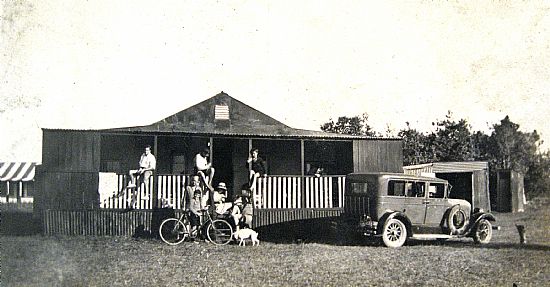
We also had Woodlands Farm at which we spent some of our holidays. Now owned by Uncle George Jones [my mother's cousin] it was originally bought by our Great Grandfather Joseph Miller in 1872 and here my grandmother Ida Newman was brought up and it was from here that she married Grandfather Angus William Newman. When we first visited we stayed in the original stone house built by Joseph. By the early 1930's George had sold half the farm and built a large and commodious house at the west end of the Farm overlooking the Buffalo River – this house is now the water bailiff's house.
I have been to two houses in that area in the 1970's, but am unsure which is relevant. Both derelict. At about that time two things happened which affected that and other properties in the area. Apartheid was in the process of establishing the “independent” state of Ciskei and the Bridledrift Dame was being built on the Buffalo River. While a fairly large dam, comparatively little of the farms was flooded. What was more damaging was the creation of a broad “buffer zone” around the dam and hindering settlement of local people close to the city's new water supply. The black township of Mdantsane grew apace in the same area and was to reach a population of half a million before apartheid ended. Politics had interfered.
Graham and Brian had happy holidays there with our 2nd cousin Jim and Chum Jones, canoeing on the river, scrambling on the krantzs and chasing hares. We did not get involved in hunting bushbuck.
This happy life came to a sudden halt in July 1934. Graham and Brian were bundled out to the farm during the June school holidays. We knew that Dad [A.R.W] was not well but we were not prepared when Uncle George Jones told us after supper one evening that our beloved Dad had passed on. We were not allowed to go the funeral which made the whole episode so much more unhappy.
We stayed on at Sea View Terrace for a few months but Mother [Maud] was advised to take a smaller house and we soon moved to 19 Hillview Road into which we just managed to fit. She was also advised by her lawyer to sell the small block of flats as the bond rate had just increased from 6% to 6 1/2% and he felt that she as a woman was in no position to maintain such as a building.
This was a miserable period, the tenants were trying to run 4 Sea View Terrace as a boarding house and it as deteriorating. After the first years lease had expired Mother decided that she could do better by running a “Boarding House”with her own family and Jim Jones who had just started as an Electrical Apprentice was our first guest; other young friends came from time to time and friends and relations came during holidays.
Maud was looking after 5 of her own boys : Jack, Dennis, Scott, Brian and Graham. (These are the names I knew them as. Their fuller names and first names were not quite the same and nicknames can also confuse). That home must have been very busy. My father used to tell of a house so basic and ill maintained that they could creep out through a hole in the corrugated iron.
Their time in St Peters Road in Southernwood had a surprising episode. One day this contraption looking much like a bicycle with wings made its way past the house.
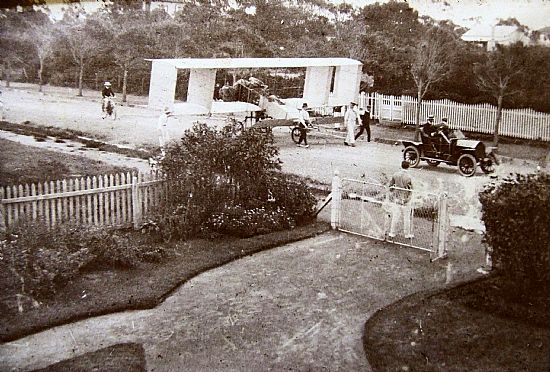
This was the biplane to be demonstrated by Albert Kimmerling - one of the very first powered flights in South Africa. The view is believed to be from the family home. For more on the event and Kimmerling follow this link (and note that the picture appears on the website too).
Below is a snuff box. I am guessing as to its exact provenance, but I interpret the note left inside as from James Watson to his son Alexander Watson - Alick being an abbreviation. This would mean that it was used by Alexander's great grandfather, the earlier James Watson who died at Stirling in 1844. I have no idea who the hair belonged to.
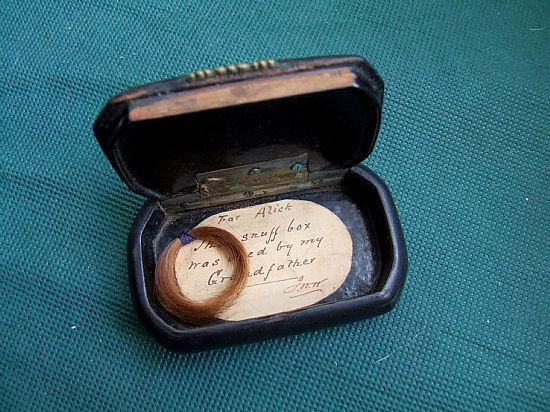
FLIGHTLINEWEEKLY : http://www.flightlineweekly.com/single-post/2018/05/01/The-First-Powered-Flight-in-South-Africa

